
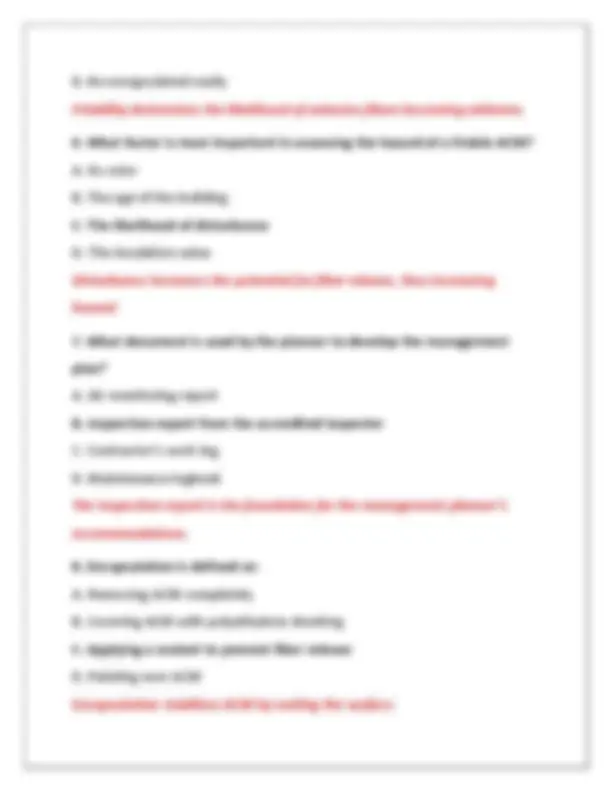
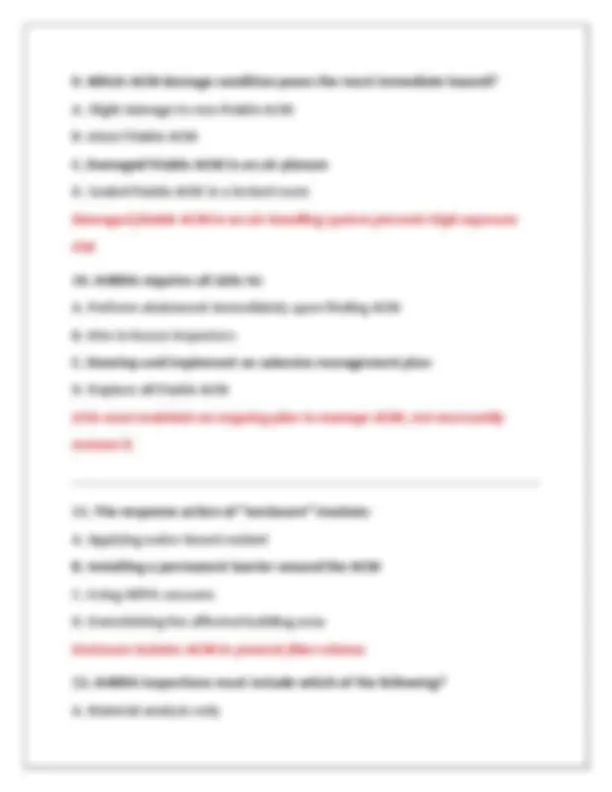
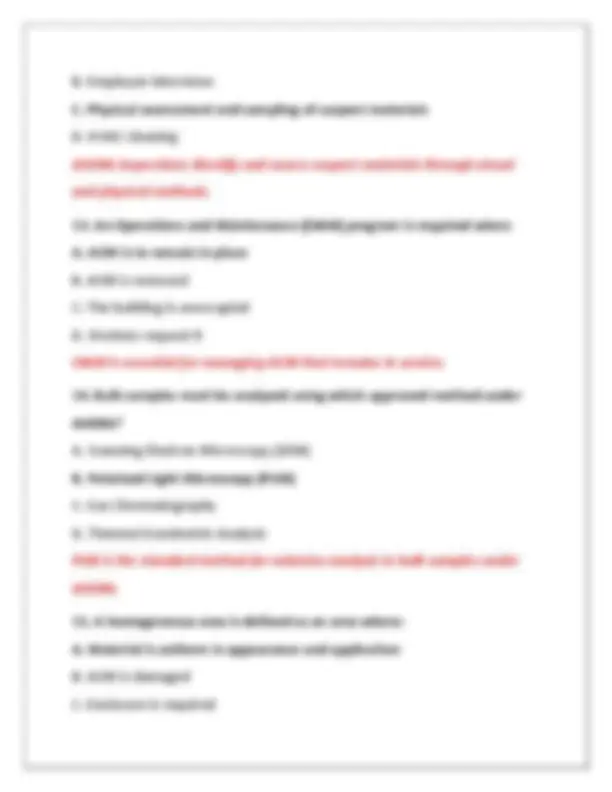
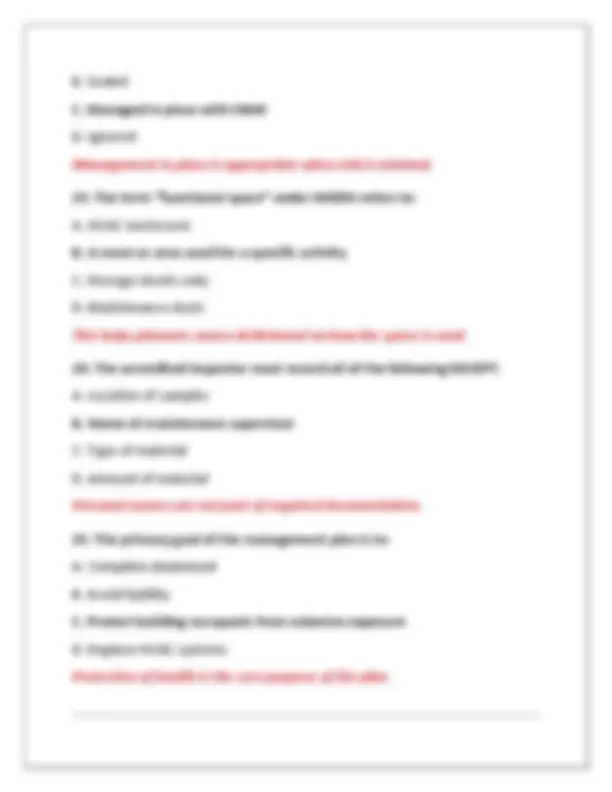
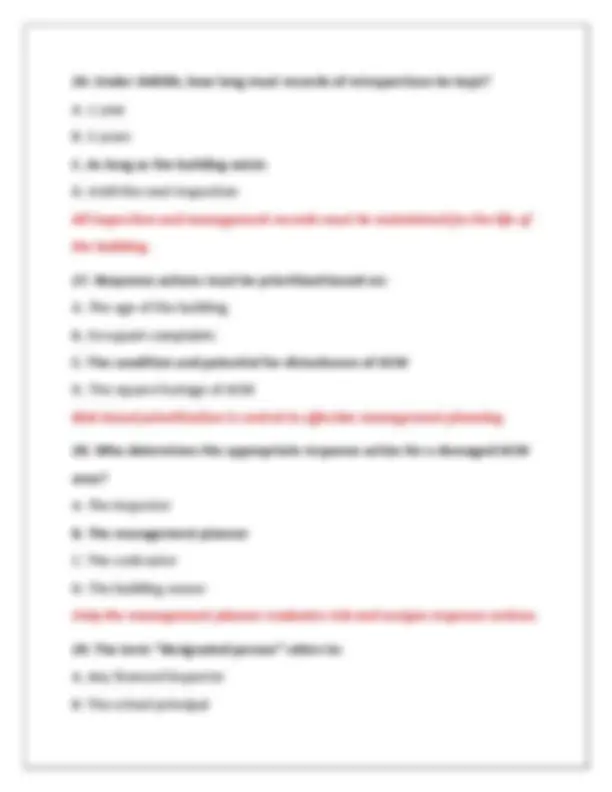
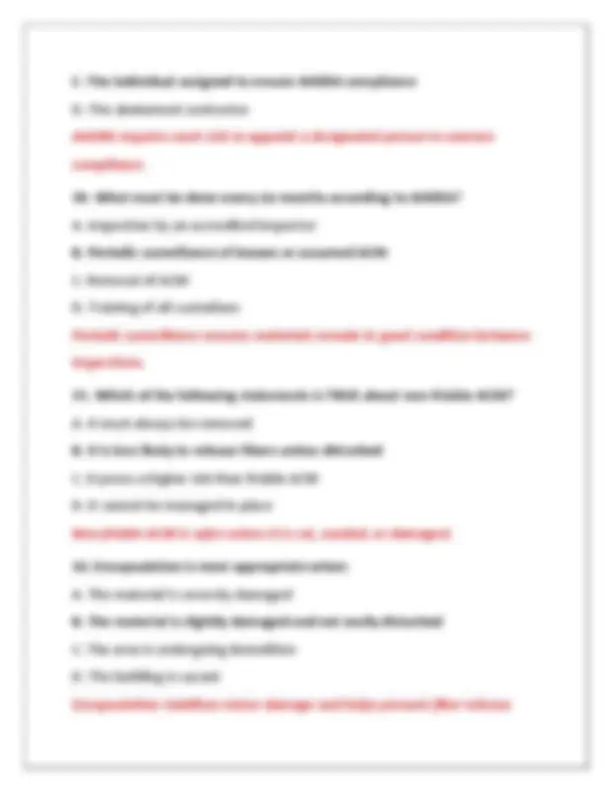
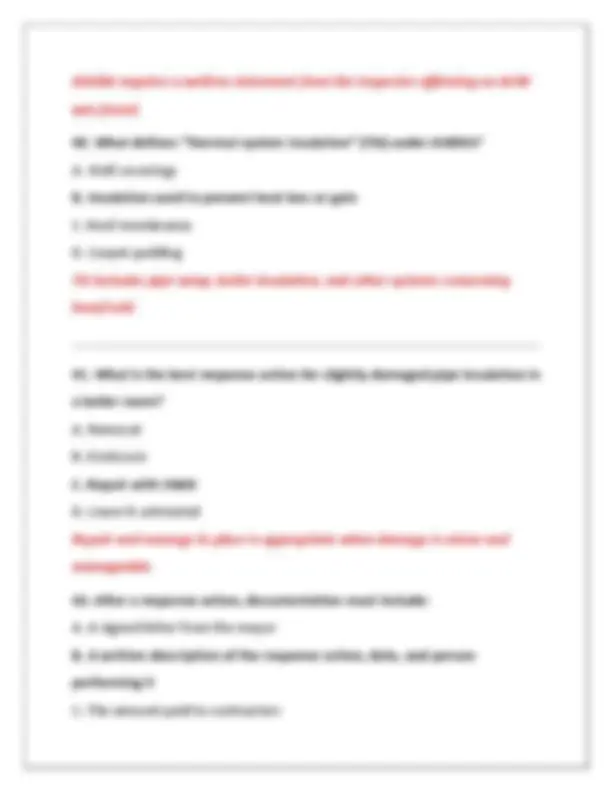
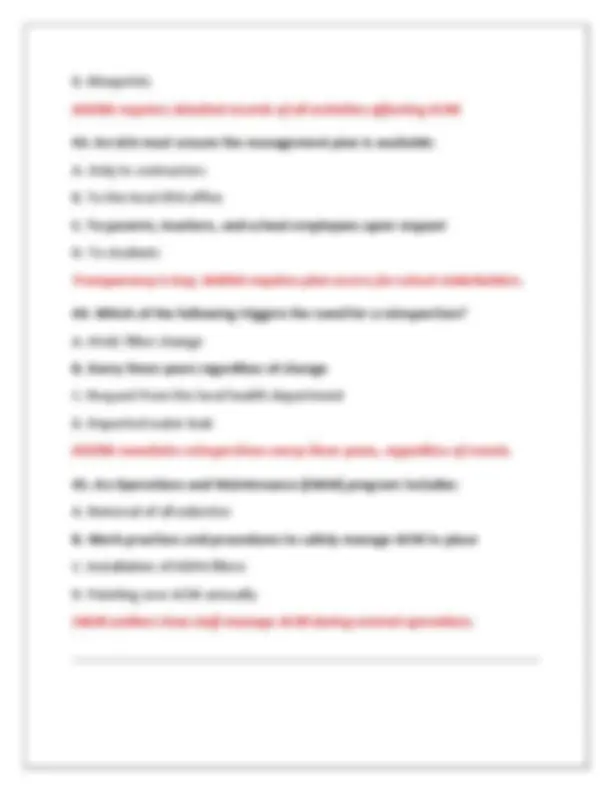
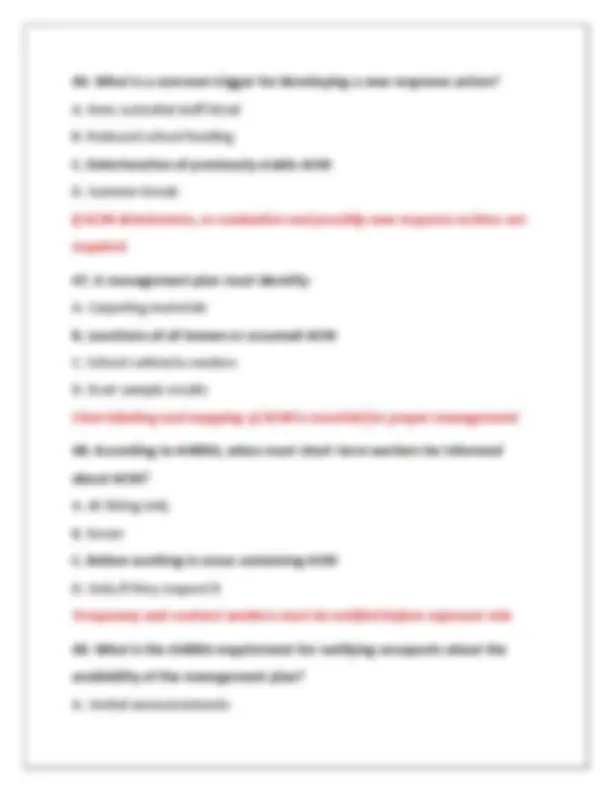
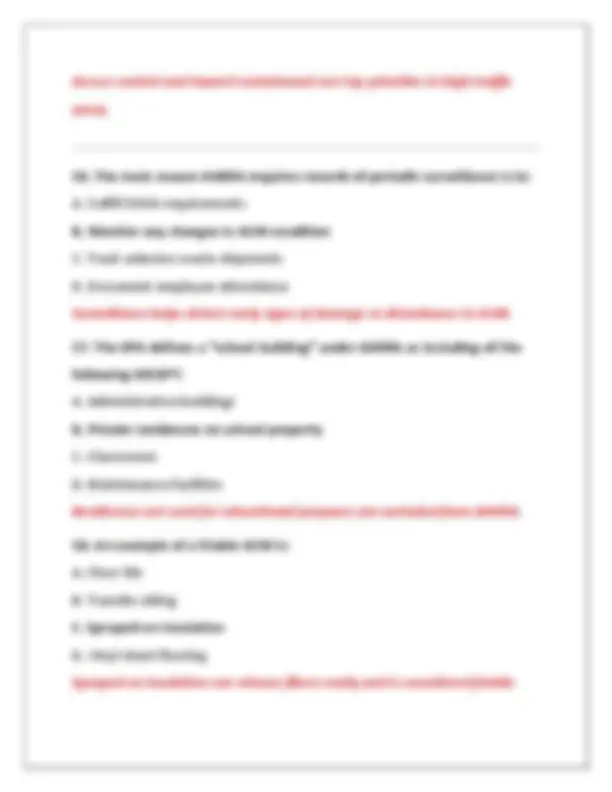

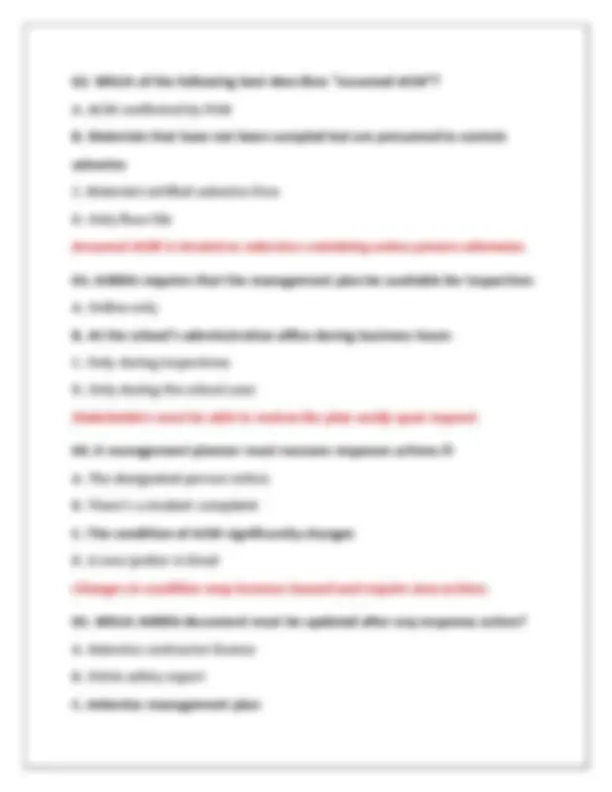
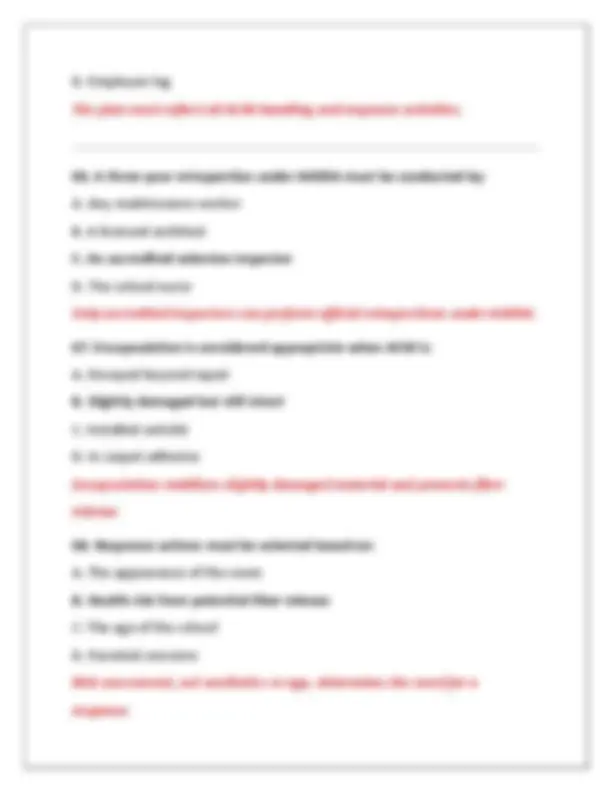
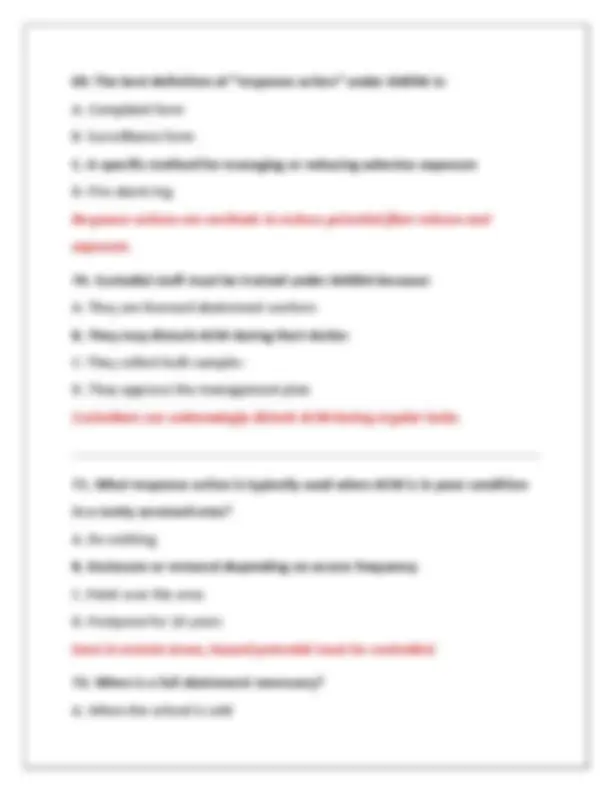
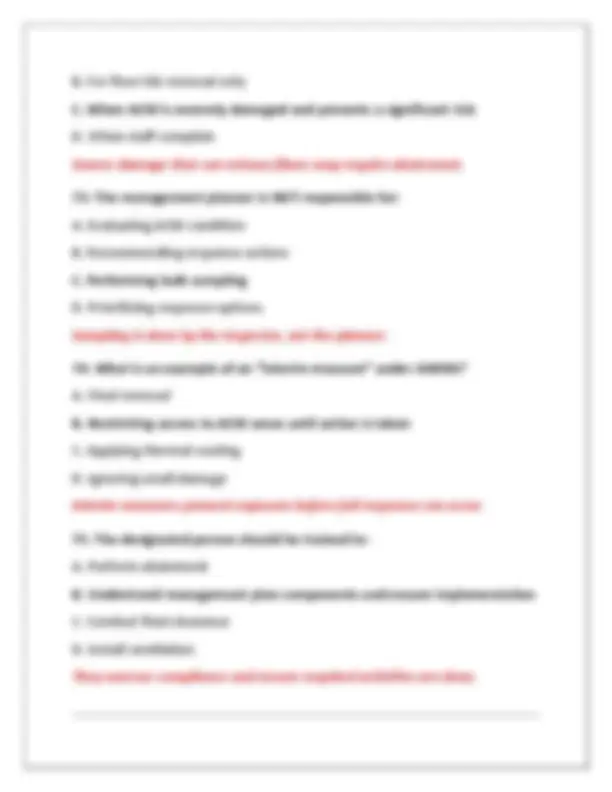
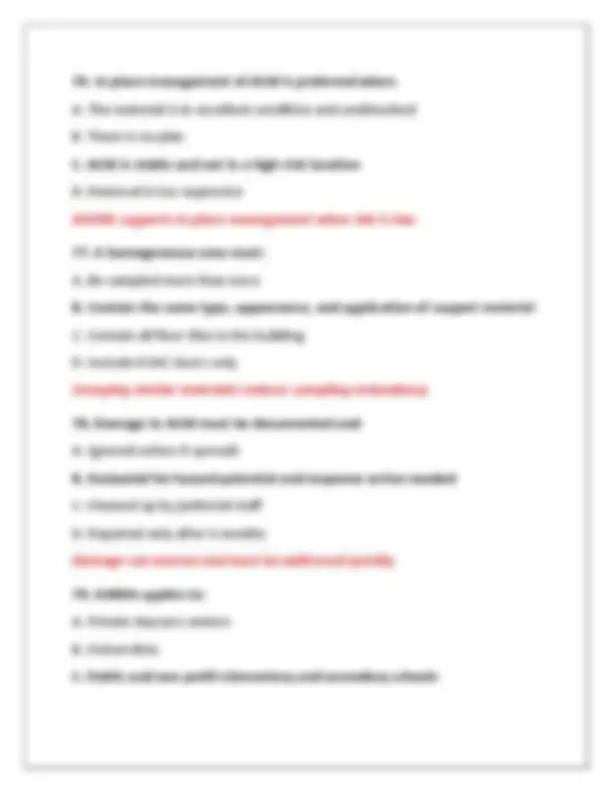
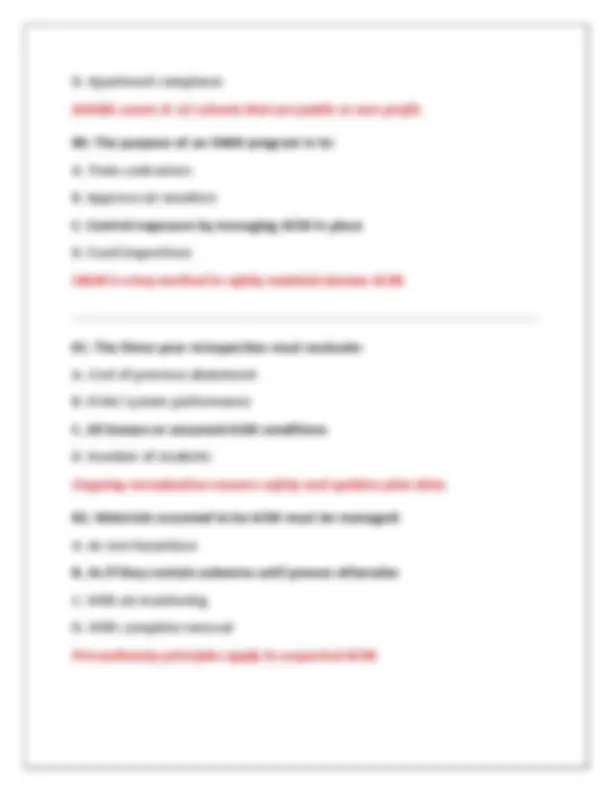
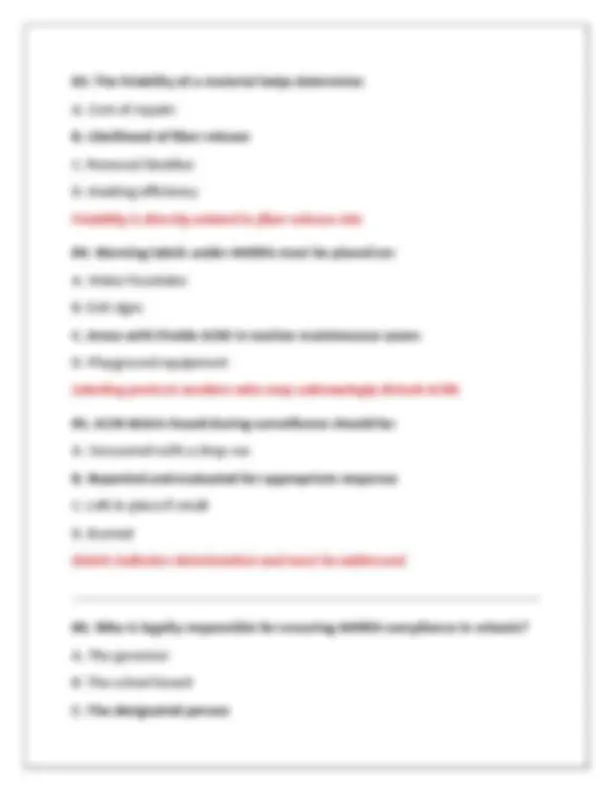
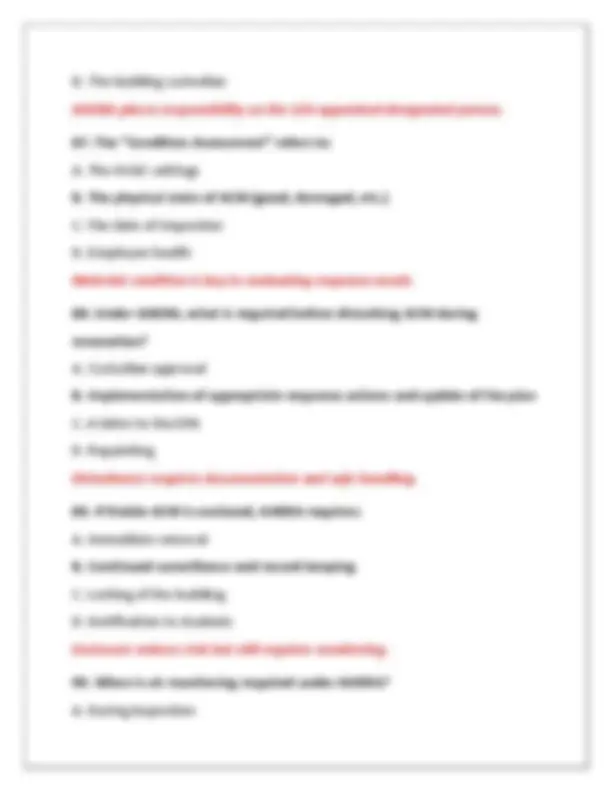
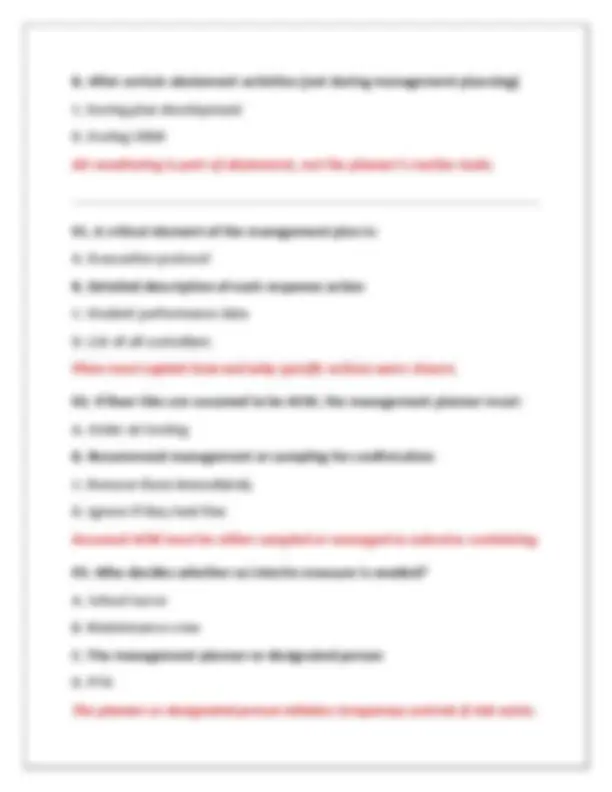
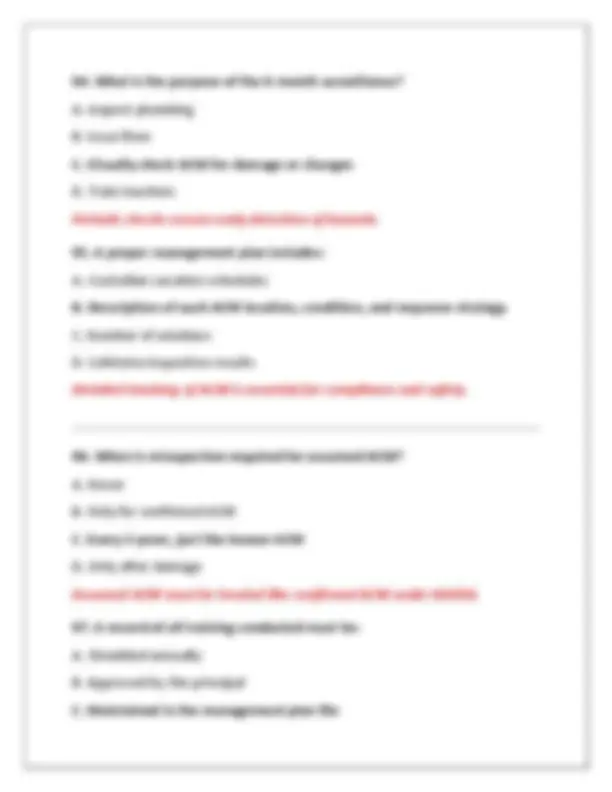
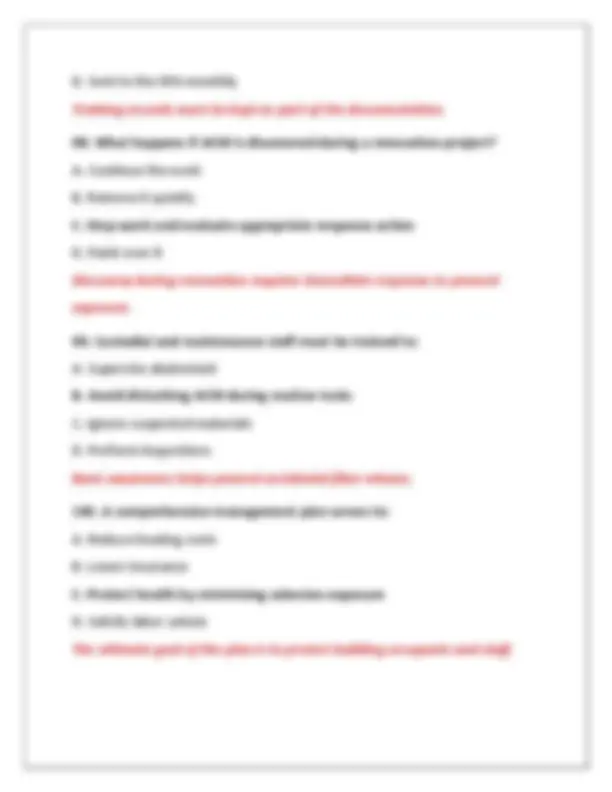


Study with the several resources on Docsity

Earn points by helping other students or get them with a premium plan


Prepare for your exams
Study with the several resources on Docsity

Earn points to download
Earn points by helping other students or get them with a premium plan
Community
Ask the community for help and clear up your study doubts
Discover the best universities in your country according to Docsity users
Free resources
Download our free guides on studying techniques, anxiety management strategies, and thesis advice from Docsity tutors
AHERA Management Planner Certification Exam Practice Test 2questions And Correct Answers (Verified Answers) Plus Rationales 2025 Q&A | Instant Download Pdf
Typology: Exams
1 / 30

This page cannot be seen from the preview
Don't miss anything!























1. What is the primary responsibility of an AHERA Management Planner? A. Conduct air sampling for asbestos B. Develop response action recommendations based on inspection reports C. Perform bulk sampling of suspected ACM D. Supervise asbestos abatement work The management planner’s main task is to use the inspector’s report to evaluate hazards and recommend response actions. 2. Under AHERA, what type of building must have an asbestos management plan? A. Commercial buildings B. Private residences C. Public and non-profit elementary and secondary schools
D. Industrial facilities AHERA specifically regulates public and non-profit K–12 schools.
3. Which of the following is NOT a response action defined by AHERA? A. Removal B. Monitoring C. Repair D. Encapsulation Monitoring is not a formal response action; it is part of O&M. Response actions include removal, enclosure, encapsulation, repair, and maintenance. 4. How often must an AHERA management plan be reviewed and updated? A. Every six months B. Every five years C. Every two years D. At least once per year AHERA requires the plan to be reviewed annually and updated as necessary. 5. The friability of asbestos-containing material (ACM) is determined by its ability to: A. Be dissolved in water B. Be crumbled, pulverized, or reduced to powder by hand pressure C. Resist heat and fire
9. Which ACM damage condition poses the most immediate hazard? A. Slight damage to non-friable ACM B. Intact friable ACM C. Damaged friable ACM in an air plenum D. Sealed friable ACM in a locked room Damaged friable ACM in an air-handling system presents high exposure risk. 10. AHERA requires all LEAs to: A. Perform abatement immediately upon finding ACM B. Hire in-house inspectors C. Develop and implement an asbestos management plan D. Replace all friable ACM LEAs must maintain an ongoing plan to manage ACM, not necessarily remove it. 11. The response action of "enclosure" involves: A. Applying water-based sealant B. Installing a permanent barrier around the ACM C. Using HEPA vacuums D. Demolishing the affected building area Enclosure isolates ACM to prevent fiber release. 12. AHERA inspections must include which of the following? A. Material analysis only
B. Employee interviews C. Physical assessment and sampling of suspect materials D. HVAC cleaning AHERA inspections identify and assess suspect materials through visual and physical methods.
13. An Operations and Maintenance (O&M) program is required when: A. ACM is to remain in place B. ACM is removed C. The building is unoccupied D. Workers request it O&M is essential for managing ACM that remains in service. 14. Bulk samples must be analyzed using which approved method under AHERA? A. Scanning Electron Microscopy (SEM) B. Polarized Light Microscopy (PLM) C. Gas Chromatography D. Thermal Gravimetric Analysis PLM is the standard method for asbestos analysis in bulk samples under AHERA. 15. A homogeneous area is defined as an area where: A. Material is uniform in appearance and application B. ACM is damaged C. Enclosure is required
LEAs must provide 30-day notice that the management plan is available for review.
20. Which of the following is NOT a responsibility of the Designated Person under AHERA? A. Ensuring inspections are conducted B. Performing removal work C. Notifying workers of asbestos locations D. Overseeing O&M activities The Designated Person coordinates, but does not perform abatement. 21. What is the significance of “potential for disturbance” in AHERA assessments? A. It determines the type of fiber B. It influences the choice of response action C. It indicates building age D. It eliminates need for sampling High potential for disturbance increases the urgency for action. 22. ACM in good condition with low potential for disturbance should be: A. Removed
B. Sealed C. Managed in place with O&M D. Ignored Management in place is appropriate when risk is minimal.
23. The term “functional space” under AHERA refers to: A. HVAC enclosures B. A room or area used for a specific activity C. Storage closets only D. Maintenance ducts This helps planners assess ACM based on how the space is used. 24. The accredited inspector must record all of the following EXCEPT: A. Location of samples B. Name of maintenance supervisor C. Type of material D. Amount of material Personal names are not part of required documentation. 25. The primary goal of the management plan is to: A. Complete abatement B. Avoid liability C. Protect building occupants from asbestos exposure D. Replace HVAC systems Protection of health is the core purpose of the plan.
C. The individual assigned to ensure AHERA compliance D. The abatement contractor AHERA requires each LEA to appoint a designated person to oversee compliance.
30. What must be done every six months according to AHERA? A. Inspection by an accredited inspector B. Periodic surveillance of known or assumed ACM C. Removal of ACM D. Training of all custodians Periodic surveillance ensures materials remain in good condition between inspections. 31. Which of the following statements is TRUE about non-friable ACM? A. It must always be removed B. It is less likely to release fibers unless disturbed C. It poses a higher risk than friable ACM D. It cannot be managed in place Non-friable ACM is safer unless it is cut, sanded, or damaged. 32. Encapsulation is most appropriate when: A. The material is severely damaged B. The material is slightly damaged and not easily disturbed C. The area is undergoing demolition D. The building is vacant Encapsulation stabilizes minor damage and helps prevent fiber release.
33. Which is considered a high-priority area for response action planning? A. Custodial closet B. Air plenum or return duct with friable ACM C. Storage room with intact ACM D. Unoccupied mechanical room Friable ACM in areas connected to air distribution presents significant risk. 34. The AHERA Management Plan must include: A. A floor plan with abatement schedules B. An evaluation of response options and recommended actions C. HVAC specifications D. Air sampling logs Plans must provide justification for selected response actions based on hazard evaluation. 35. When evaluating response actions, planners must consider: A. Contractor availability B. Cost only C. Occupant exposure risk and material condition D. Future renovation plans only Health risk and ACM condition are primary planning factors under AHERA. 36. Which of the following is a responsibility of the designated person? A. Performing bulk sampling B. Ensuring custodial staff receive 2-hour asbestos awareness training
AHERA requires a written statement from the inspector affirming no ACM was found.
40. What defines "thermal system insulation" (TSI) under AHERA? A. Wall coverings B. Insulation used to prevent heat loss or gain C. Roof membranes D. Carpet padding TSI includes pipe wrap, boiler insulation, and other systems conserving heat/cold. 41. What is the best response action for slightly damaged pipe insulation in a boiler room? A. Removal B. Enclosure C. Repair with O&M D. Leave it untreated Repair and manage in place is appropriate when damage is minor and manageable. 42. After a response action, documentation must include: A. A signed letter from the mayor B. A written description of the response action, date, and person performing it C. The amount paid to contractors
D. Blueprints AHERA requires detailed records of all activities affecting ACM.
43. An LEA must ensure the management plan is available: A. Only to contractors B. To the local EPA office C. To parents, teachers, and school employees upon request D. To students Transparency is key; AHERA requires plan access for school stakeholders. 44. Which of the following triggers the need for a reinspection? A. HVAC filter change B. Every three years regardless of change C. Request from the local health department D. Reported water leak AHERA mandates reinspections every three years, regardless of events. 45. An Operations and Maintenance (O&M) program includes: A. Removal of all asbestos B. Work practices and procedures to safely manage ACM in-place C. Installation of HEPA filters D. Painting over ACM annually O&M outlines how staff manage ACM during normal operations.
B. Monthly meetings C. Annual written notification D. Biannual email reminders AHERA requires written notice at least annually to parents, teachers, and employees.
50. What qualifies as a "response action" under AHERA? A. Fire alarm testing B. Enclosure, encapsulation, repair, or removal of ACM C. Air sampling D. Routine sweeping Response actions are strategies to reduce or eliminate ACM hazards. 51. Which of the following does NOT require AHERA accreditation to perform? A. Asbestos inspection B. Management plan preparation C. Reinspection D. Custodial surveillance Custodial surveillance can be done by trained staff but not necessarily accredited. 52. If ACM is accidentally disturbed during maintenance, the designated person must: A. Cover it with plastic B. Evacuate the school
C. Record the event and initiate response procedures D. Ignore it if no one is harmed Accidental disturbance must be documented and remediated immediately.
53. Who approves or certifies the AHERA management planner's accreditation? A. OSHA B. Local zoning department C. EPA or EPA-authorized state program D. LEA Accreditation is granted by EPA or delegated state programs. 54. How long must documentation of response actions be kept under AHERA? A. 6 months B. For the life of the building C. Until the next response action D. 1 year Records must be preserved permanently as part of the management plan. 55. If ACM is identified in a high-traffic hallway, the most appropriate immediate response might be: A. Do nothing B. Enclosure or temporary barrier and initiate further evaluation C. Removal without notice D. Paint over the area
59. Under AHERA, who must receive annual notification about the availability of the management plan? A. Contractors B. Local fire department C. Parents, teachers, and employee organizations D. Students Annual notice must be provided to those regularly occupying the building. 60. What is the first step a management planner should take after reviewing an inspection report? A. Recommend removal B. Seal all ACM C. Evaluate the potential for fiber release and exposure D. Prepare air samples Evaluation of hazard potential is essential before selecting a response. 61. A proper response action for ACM in good condition but located in a return air plenum is: A. Leave it untouched B. Enclosure or removal due to air movement concerns C. Paint it D. Postpone for 10 years Friable ACM in air pathways requires more aggressive controls to protect air quality.
62. Which of the following best describes "assumed ACM"? A. ACM confirmed by PLM B. Materials that have not been sampled but are presumed to contain asbestos C. Material certified asbestos-free D. Only floor tile Assumed ACM is treated as asbestos-containing unless proven otherwise. 63. AHERA requires that the management plan be available for inspection: A. Online only B. At the school’s administrative office during business hours C. Only during inspections D. Only during the school year Stakeholders must be able to review the plan easily upon request. 64. A management planner must reassess response actions if: A. The designated person retires B. There’s a student complaint C. The condition of ACM significantly changes D. A new janitor is hired Changes in condition may increase hazard and require new actions. 65. Which AHERA document must be updated after any response action? A. Asbestos contractor license B. OSHA safety report C. Asbestos management plan